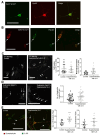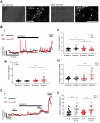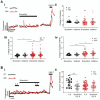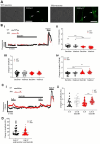Neuronal hyperexcitability in dystrophin-deficient mdx hippocampal neurons: the importance of interleukin-6 and GABAergic regulation
- PMID: 40447687
- PMCID: PMC12125231
- DOI: 10.1038/s41598-025-00880-z
Neuronal hyperexcitability in dystrophin-deficient mdx hippocampal neurons: the importance of interleukin-6 and GABAergic regulation
Abstract
Duchenne Muscular Dystrophy (DMD) is a severe neuromuscular disorder arising from loss of the structural protein, dystrophin. It also often presents with cognitive deficits and susceptibility to epilepsy. Expressed in neurons of the hippocampus, dystrophin plays an important role in synapse formation, specifically the post-synaptic organisation of γ-aminobutyric acid A receptors (GABAARs). This study explored possible interactions between interleukin (IL)-6, which is elevated in DMD, and GABAAR signalling in cultured hippocampal neurons of dystrophic mdx mice. Immunofluorescent imaging revealed altered development of network connectivity that displayed similar characteristics to dystrophin-expressing neurons cultured in elevated levels of IL-6. Mdx neurons dependably exhibited spontaneous oscillations. Calcium (Ca2+) signalling was further modulated by exposure to agonists and antagonists of GABAA and GABABRs. IL-6-evoked Ca2+ responses were enhanced by muscimol, a GABAAR agonist, in wildtype (WT) and mdx neurons, whilst bicuculline, a GABAAR antagonist, only suppressed IL-6-evoked Ca2+activity in WT neurons. The GABABR agonist, baclofen, enhanced IL-6-evoked Ca2+ responses only in mdx neurons. Our findings support dysfunctional GABAergic signalling in hippocampal neurons that lack dystrophin, resulting in aberrant neuronal network excitability. The contribution of elevated levels of IL-6 further impact upon Ca2+ dyshomeostasis in dystrophic neurons and may underpin cognitive changes reported in dystrophinopathies.
Keywords: Duchenne muscular dystrophy; Dystrophin; GABA; Hippocampus; Learning; Memory.
© 2025. The Author(s).
Conflict of interest statement
Declarations. Competing interests: The authors declare no competing interests. Ethics approval: All animal experiments were approved and performed following guidelines set out by the HPRA (Health Products Regulatory Authority), Ireland and following project authorisation (AEI9130/P088), as well as individual authorisation (AEI9130/I303). Animals were euthanized in accordance with European Directive 2010/63/EU.
Figures








Similar articles
-
Altered release and uptake of gamma-aminobutyric acid in the cerebellum of dystrophin-deficient mice.Neurochem Int. 2018 Sep;118:105-114. doi: 10.1016/j.neuint.2018.06.001. Epub 2018 Jun 1. Neurochem Int. 2018. PMID: 29864448
-
Astrocyte proliferation in the hippocampal dentate gyrus is suppressed across the lifespan of dystrophin-deficient mdx mice.Exp Physiol. 2025 Apr;110(4):585-598. doi: 10.1113/EP092150. Epub 2025 Jan 10. Exp Physiol. 2025. PMID: 39792584 Free PMC article.
-
Facilitated CA1 hippocampal synaptic plasticity in dystrophin-deficient mice: role for GABAA receptors?Hippocampus. 2002;12(6):713-7. doi: 10.1002/hipo.10068. Hippocampus. 2002. PMID: 12542223
-
Brain function in Duchenne muscular dystrophy.Brain. 2002 Jan;125(Pt 1):4-13. doi: 10.1093/brain/awf012. Brain. 2002. PMID: 11834588 Review.
-
Interleukin-6: A neuro-active cytokine contributing to cognitive impairment in Duchenne muscular dystrophy?Cytokine. 2020 Sep;133:155134. doi: 10.1016/j.cyto.2020.155134. Epub 2020 May 23. Cytokine. 2020. PMID: 32454436 Review.
References
-
- Lynch, G. S. Role of contraction-induced injury in the mechanisms of muscle damage in muscular dystrophy. Clin. Exp. Pharmacol. Physiol.31, 557–561 (2004). - PubMed
-
- McDonald, C. M. et al. Long-term effects of glucocorticoids on function, quality of life, and survival in patients with Duchenne muscular dystrophy: A prospective cohort study. Lancet391, 451–461 (2018). - PubMed
-
- Felisari, G. et al. Loss of Dp140 dystrophin isoform and intellectual impairment in Duchenne dystrophy. Neurology55, 559–564 (2000). - PubMed
MeSH terms
Substances
Grants and funding
LinkOut - more resources
Full Text Sources
Miscellaneous

